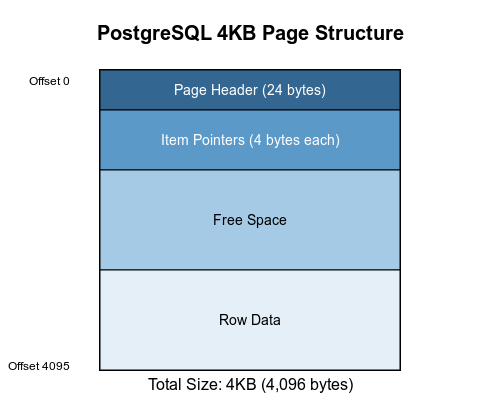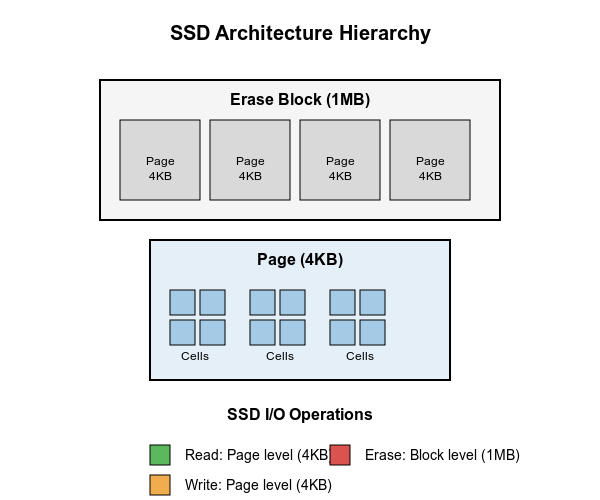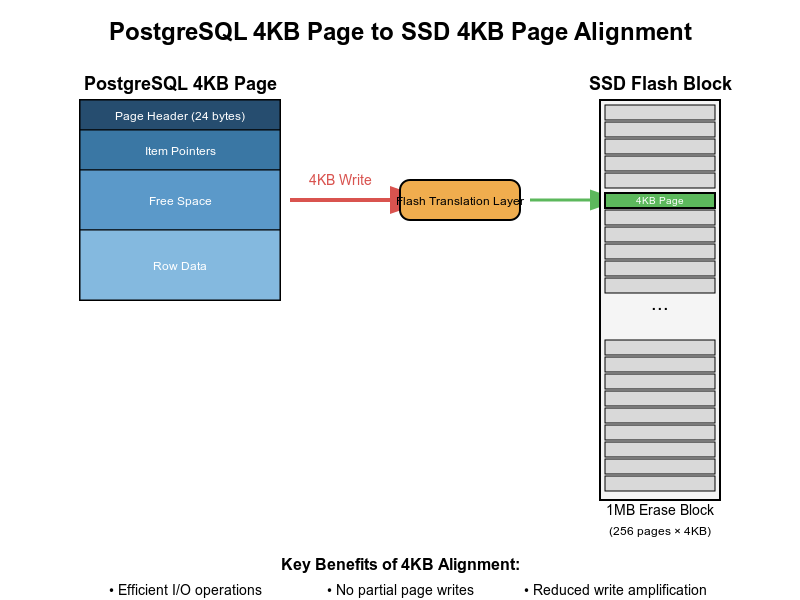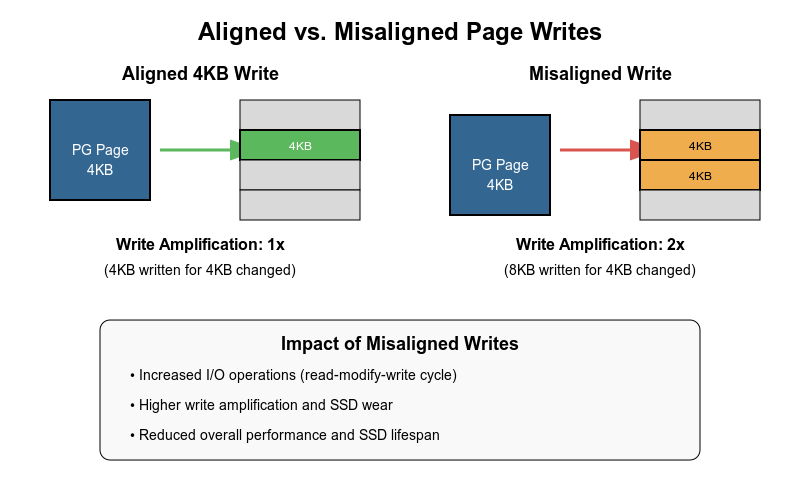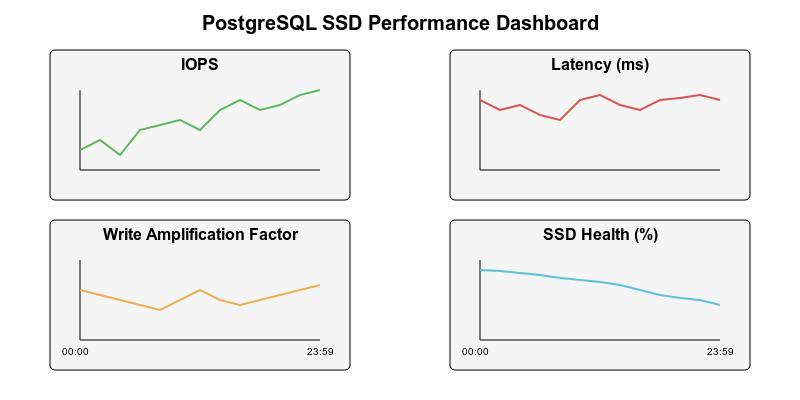How PostgreSQL's 4KB Pages Optimize SSD Storage Performance
An exploration of how PostgreSQL's 4KB page architecture optimizes SSD storage performance and data access patterns.
Introduction
Database performance optimization remains one of the most critical aspects of modern application architecture. As data volumes grow exponentially, the efficiency of database operations becomes increasingly important.
PostgreSQL, one of the world’s most advanced open-source relational database systems, has several features that make it particularly well-suited for modern storage technologies like Solid State Drives (SSDs).
In this article, we’ll explore one of the more overlooked aspects of database performance: the alignment between PostgreSQL’s internal page size and the physical page size of modern SSDs. This natural alignment creates significant performance advantages that many database administrators and developers might not fully appreciate.
Understanding PostgreSQL’s Storage Model
PostgreSQL organizes its data in fixed-size pages (blocks), which are the fundamental units of I/O operations. By default, each page is 8,192 bytes (8KB), though this can be configured to 4KB during compilation. For our discussion, we’ll focus on the 4KB configuration since it creates a particularly advantageous alignment with modern SSD architecture.
The Page Structure
Each PostgreSQL page has a specific structure:
- Page Header (24 bytes): Contains metadata about the page, including free space pointers and transaction visibility information
- Item Pointers (4 bytes each): Point to the actual row data within the page
- Free Space: The area where new row data can be added
- Row Data: The actual data stored in the page, organized from the bottom up
PostgreSQL Page StructureWhen PostgreSQL performs a write operation, it writes entire pages to disk. Even if only a few bytes within a page are modified, the entire page is written as a single unit. This is known as a “page-level write granularity” and is fundamental to understanding how PostgreSQL interacts with storage systems.
SSD Architecture Fundamentals
Before diving into the alignment benefits, it’s crucial to understand how SSDs store and manage data. Unlike traditional hard disk drives (HDDs) with spinning platters and movable read/write heads, SSDs use flash memory organized into a hierarchy of structures:
- Cells: The smallest unit, capable of storing one or more bits
- Pages: Collection of cells, typically 4KB or 8KB in size
- Blocks: Collection of pages, typically 128KB to 4MB in size
The key characteristic of SSDs that affects database performance is their asymmetrical read/write behavior:
- Reads: Can occur at the page level (4KB)
- Writes: Can also occur at the page level, but…
- Erases: Can only happen at the block level
This creates a unique constraint: to update even a single byte on an SSD, the drive must:
- Read the entire block into cache
- Modify the data in the cache
- Erase the entire block
- Write back the modified data
This process is known as “write amplification” and is one of the primary factors affecting SSD performance and longevity.
SSD Architecture HierarchyThe Perfect Alignment: PostgreSQL and SSDs
The Perfect Alignment: PostgreSQL and SSDs
Now, let’s examine the fortuitous alignment between PostgreSQL’s 4KB pages and SSD’s 4KB pages. This alignment creates several performance advantages that significantly improve database operations on SSDs.
PostgreSQL to SSD Page AlignmentBenefits of Perfect Alignment
Elimination of Partial Page Writes
When a database page aligns perfectly with an SSD page, the SSD controller can efficiently handle write operations. Every PostgreSQL page write corresponds exactly to a single SSD page write. This eliminates the “read-modify-write” penalty that occurs when a write operation spans multiple SSD pages.
Without proper alignment, a single database page might straddle two SSD pages. This means that even a small change to a database page could require the SSD to:
- Read both SSD pages into memory
- Modify the relevant portions
- Write back both pages
This process doubles the I/O operations and increases write amplification.
Reduced Write Amplification
Write amplification is the ratio between the amount of data actually written to the SSD versus the amount of data requested by the host system. Due to the block-erase nature of SSDs, this ratio can be significantly higher than 1:1.
When PostgreSQL’s 4KB pages align perfectly with the SSD’s 4KB pages, write amplification is minimized in several ways:
- The SSD’s garbage collection processes can operate more efficiently
- Wear-leveling algorithms can distribute writes more evenly
- The Flash Translation Layer (FTL) can maintain more straightforward mapping tables
The following diagram illustrates how misaligned writes can increase write amplification: Write AmplificationImproved TRIM/DISCARD Operation Efficiency
Improved TRIM/DISCARD Operation Efficiency
Modern SSDs support the TRIM command (called DISCARD in PostgreSQL), which allows the operating system to inform the SSD which blocks of data are no longer in use. This enables more efficient garbage collection and wear leveling.
When PostgreSQL pages align perfectly with SSD pages, TRIM operations work more effectively because the database can precisely identify which SSD pages are no longer needed. This leads to more efficient storage utilization and potentially extends the SSD’s lifespan.
Enhanced Performance for Random I/O
PostgreSQL heavily depends on random I/O operations, especially for index scans and non-sequential table accesses. SSDs excel at random I/O compared to HDDs, but the performance can vary significantly based on the alignment of the data.
When PostgreSQL’s 4KB pages align with SSD pages, random I/O operations become more efficient, leading to:
- Lower latency for individual queries
- Improved throughput for concurrent operations
- Better overall database responsiveness
PostgreSQL Configuration for Optimal SSD Performance
To maximize the benefits of this natural alignment, several PostgreSQL configuration parameters should be optimized for SSD storage:
1. Block Size Configuration
While the default PostgreSQL block size is 8KB, configuring a 4KB block size at compilation time can provide better alignment with most modern SSDs. This requires recompiling PostgreSQL with the --with-blocksize=4 option:
1
2
3
./configure --with-blocksize=4 [other options]
make
make install
2. Checkpointing Parameters
Checkpoints in PostgreSQL flush dirty pages to disk, creating I/O spikes that can impact performance. For SSDs, spreading these operations is beneficial:
1
2
3
4
# More frequent but less intensive checkpoints
checkpoint_timeout = 10min
max_wal_size = 2GB
checkpoint_completion_target = 0.9
3. Write-Ahead Log (WAL) Settings
The Write-Ahead Log is critical for PostgreSQL’s durability guarantees. For SSDs:
1
2
3
4
5
# Optimized for SSD storage
wal_level = replica
wal_buffers = 16MB
wal_writer_delay = 200ms
wal_compression = on
4. Vacuum and Autovacuum Settings
Proper vacuum settings help maintain SSD performance over time by efficiently reclaiming space:
1
2
3
4
5
# Enhanced vacuum settings for SSDs
autovacuum = on
autovacuum_max_workers = 4
autovacuum_naptime = 1min
vacuum_cost_delay = 2ms
5. DISCARD Support
Enabling DISCARD (TRIM) support helps maintain SSD performance:
1
2
# Enable DISCARD for freed space
enable_discard = on
Real-World Implementation Strategies
Implementing optimal PostgreSQL-SSD alignment requires attention to several aspects of your database deployment. Here are practical strategies to ensure you’re getting the most out of this natural alignment:
File System Considerations
The file system layer sits between PostgreSQL and the SSD, making it a critical component in the I/O path. For optimal performance:
- Use modern file systems: XFS or ext4 are generally recommended for PostgreSQL on Linux
- Proper mount options: Include
noatimeandnodiratimeto reduce unnecessary metadata updates - File system alignment: Ensure that the file system’s allocation units align with SSD pages
A recommended mount configuration in /etc/fstab might look like:
1
/dev/nvme0n1p1 /var/lib/postgresql xfs noatime,nodiratime,discard 0 0
The discard option enables real-time TRIM support, though batch TRIM via periodic fstrim commands is often preferred for busy production systems.
Storage Provisioning Best Practices
When provisioning SSD storage for PostgreSQL:
- Over-provisioning: Allocate 10–20% more space than needed and leave it unpartitioned to enhance SSD endurance and performance
- RAID considerations: If using RAID, ensure stripe sizes are multiples of 4KB
- Volume managers: When using LVM or similar tools, align physical extents with SSD page boundaries
Monitoring and Maintenance
Ongoing monitoring helps maintain optimal performance:
- I/O statistics: Monitor IOPS, throughput, and latency using tools like
iostat, Prometheus, or Grafana - SSD health: Track SMART attributes to monitor SSD wear levels
- Write amplification: Some SSDs provide this metric through vendor-specific tools
PostgreSQL SSD Performance DashboardAdvanced Optimization Techniques
Advanced Optimization Techniques
Beyond the basic alignment, several advanced techniques can further enhance PostgreSQL performance on SSDs:
1. Tablespace Segregation
Segregating tables and indexes into different tablespaces can improve I/O patterns:
1
2
3
4
5
6
7
-- Create tablespaces on separate SSDs
CREATE TABLESPACE ts_tables LOCATION '/path/to/ssd1/tables';
CREATE TABLESPACE ts_indexes LOCATION '/path/to/ssd2/indexes';
-- Create table and index in their respective tablespaces
CREATE TABLE my_table (id int, data text) TABLESPACE ts_tables;
CREATE INDEX idx_my_table ON my_table (id) TABLESPACE ts_indexes;
This approach allows different I/O patterns (sequential for tables, random for indexes) to be optimized separately.
2. FILLFACTOR Optimization
The FILLFACTOR parameter controls how full PostgreSQL packs a page:
1
2
3
4
5
-- Set a lower fillfactor for frequently updated tables
CREATE TABLE frequent_updates (
id serial PRIMARY KEY,
data text
) WITH (fillfactor = 70);
3. Strategic Partitioning
Partitioning large tables improves maintenance operations and can enhance SSD performance:
1
2
3
4
5
6
7
8
9
10
11
12
13
-- Create a partitioned table
CREATE TABLE measurements (
time_id timestamp NOT NULL,
device_id int NOT NULL,
value numeric
) PARTITION BY RANGE (time_id);
-- Create monthly partitions
CREATE TABLE measurements_y2025m01 PARTITION OF measurements
FOR VALUES FROM ('2025-01-01') TO ('2025-02-01');
CREATE TABLE measurements_y2025m02 PARTITION OF measurements
FOR VALUES FROM ('2025-02-01') TO ('2025-03-01');
This approach allows for more efficient VACUUM operations and can improve both read and write performance on SSDs.
4. Leveraging PostgreSQL 15+ Performance Features
Recent PostgreSQL versions include features specifically beneficial for SSD storage:
- Prefetching improvements: Better prediction of needed pages
- Parallel query improvements: More efficient utilization of SSD bandwidth
- Incremental sorting: Reduces I/O for complex sorting operations
Beyond Alignment: Future Trends
While the current alignment between PostgreSQL’s 4KB pages and SSD’s 4KB pages creates significant benefits, several emerging trends will shape future optimizations:
1. Computational Storage
Emerging SSDs with built-in computational capabilities can offload certain database operations directly to the storage device. This could further reduce the I/O bottleneck by processing data where it resides.
2. Zone Namespaces (ZNS) SSDs
ZNS SSDs expose their internal zones to the host, giving the database more direct control over data placement and garbage collection. This could enable PostgreSQL to make even more SSD-aware decisions about data placement.
3. Variable Page Sizes
Future PostgreSQL versions might support variable page sizes, allowing even better adaptation to underlying storage characteristics. This would enable fine-tuning for different workload patterns and storage technologies.
Conclusion
The natural alignment between PostgreSQL’s 4KB pages and SSD’s 4KB pages creates a fortuitous performance advantage that database administrators can leverage. By understanding this alignment and optimizing configurations accordingly, significant performance improvements can be achieved without expensive hardware upgrades.
This alignment is not merely a coincidence but rather a reflection of how storage technologies and database systems have evolved along similar paths. Both have converged on page sizes that balance efficiency, addressability, and performance considerations.
For database administrators and developers working with PostgreSQL on SSDs, the key takeaways are:
- Ensure proper alignment at all layers (database, file system, storage)
- Configure PostgreSQL parameters to optimize for SSD characteristics
- Consider advanced techniques like tablespace segregation and strategic partitioning
- Implement regular monitoring and maintenance to sustain performance over time
- Stay aware of emerging storage technologies that may offer new optimization opportunities
By paying attention to these often-overlooked details, you can ensure your PostgreSQL database takes full advantage of modern SSD storage capabilities, delivering better performance and reliability for your applications.
